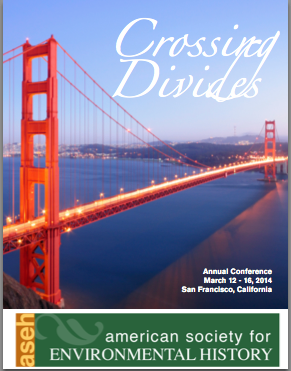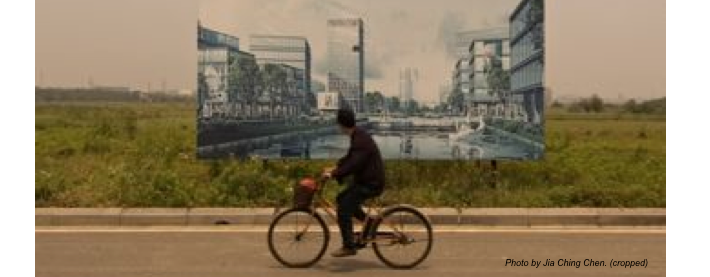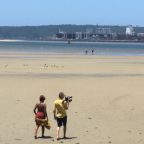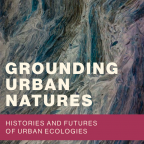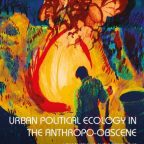This week Henrik Ernstson and Sverker Sörlin from KTH, UCT, Stanford and Princeton* are organising a special session around their book project Grounding Urban Natures at the ASEH, American Society for Environmental History Conference in San Francisco, March 12-16, 2014. The book project gathers studies from 10 urban areas on different continents and aims to ground discussions of how urban natures are re-worked across various cultural and political settings, and in different historical times.
At ASEH four chapters will be presented by Joshua Lewis on a study from New Orleans, USA, Lisa Hoffman on Dalian city in China, Lise Sedrez on Rio de Janeiro and Henrik Ernstson on Cape Town (the latter chapter is co-written with Andrew Karvonen with material from Seattle). Professor Richard Walker from UC Berkeley will serve as discussant, but he is also another of the chapter authors in the book. See venue and schedule for the session below.
Grounding discussions of urban nature in a ‘world of cities’
A general aim of the book is to learn from different disciplines and places in order to ground a broader conversation on how to research, debate and contest the histories and futures of urban natures.
More particularly the aim is to theorize how to approach and understand urban natures in a ‘world of cities’, i.e. start developing a cross-cultural theoretical repertoire for critical urban environmental studies at a historical moment when urbanisation unfolds more rapidly, in multiple ways and across various cultures, while intertwined with an ecological crisis. This begs us to engage critically with inherited academic frameworks originally developed in the West.
The book project does this through letting younger and experienced scholars from various disciplines reflect on various conflicts, projects and technologies that involve urban nature in cities where they have been working, including China, India, Nigeria, South Africa, Germany, Brazil, and the USA, spanning together a time period from early 1800s to today. These accounts demonstrate the multitude of actors, institutions and ideologies involved in re-working urban nature, from state bureaucracies , popular movements to slum dwellers, but also how the materiality of non-humans and their dynamics—including floods, sand dunes, animals and deltaic coastal systems—interact with social and political projects.
Using this rich empirical material, the aim of the book is also to critique discourses that simplify urban environments into abstract models including for instance, social-ecological systems thinking, ‘green urbanism’, ecological footprints, and ecosystem services.
*) Henrik Ernstson and Sverker Sörlin are at KTH’s Environmental Humanities Laboratory, but currently works at Stanford University and Advanced Studies in Princeton, respectively. Henrik Ernstson is also visiting scholar at University of Cape Town.
Grounding Urban Natures—Traveling the World to Re-think Histories and Futures of Political Ecologies
Panel 2-G: Mission II (Level Four)
Co-Chairs: Henrik Ernstson, University of Cape Town and Stanford University, Sverker Sörlin, Royal Institute of Technology, Sweden. Comments: Richard A. Walker, University of California, Berkeley
5 min Introduction and overview of international book project by Henrik Ernstson
Presenters:
Joshua Lewis, Stockholm University; Tulane University
The Disappearing River of New Orleans: On the Systemic Enrollment of Urban Ecosystems
12 min + 3 min for (one) question and answer
Lisa Hoffman, University of Washington
Assembling Nature in the City: Volunteering for the Envi- ronment in Dalian, China
12 min + 3 min for (one) question and answer
Lise Fernanda Sedrez, Universidade Federal do Rio de Janeiro
The Flooded City: Urban Disasters, Vulnerability and Memory in Rio de Janeiro and Buenos Aires in the 20th Century
12 min + 3 min for (one) question and answer
Henrik Ernstson, University of Cape Town & Stanford University, Andrew Karvonen, University of Manchester
Tracing the Political: Reworking Urban Natures in Cape Town and Seattle
8 min (no questions)
30 min Discussion with 10 min commentary by Richard Walker and then 20 min open questions from the audience.
Paper abstracts and session summary:
1. The Disappearing River of New Orleans: On the Systemic Enrollment of Urban Ecosystems
Joshua Lewis, Stockholm University and Tulane University.
Abstract. Urban ecologies resist our conceptualizations. We know them through the hazards they generate – like flooding and disease, and also through the benefits or services they can generate – like the aesthetics of parks and gardens, and their capacity as effective metabolizers of human and industrial waste. The enrollment of these ecologies into the process of urbanization generates new and novel dynamics for the various entities involved. Biogeochemical materials, the shifting genetic codes that assemble them as organisms, and the complex ecological relations that constitute their systemasticities are intertwined and materially interpenetrated with particular dynamics of human life and socio-political organization as they are manifest in different cities. Grasping these processes as a unity, narrating or modeling entire “urban systems” is but one approach to explicating these relations and dynamics. This chapter embarks from particularity, clarifying the origins and production of a key piece of New Orleans’ urban infrastructure that, despite its invisibility, was for many decades at the social, political, and ecological nexus of a cityscape that was simultaneously spatially expanding and sinking. This chapter explores the life of the “disappearing river” — an enormous concrete drainage siphon that was necessary for the city’s port and drainage system to operate simultaneously. I describe how the siphon emerged as a way to resolve the contradictions inherent in conflicting modes of urban governance and modernist engineering that sought a dry, sanitary, and yet still navigable, urbanized delta. Until they fail, water infrastructures like the siphon can disappear from public concern — but even in their invisibility they are territorializing new material flows and ecological processes. The siphon altered the spatial extent of pre-existing drainage basins and patterns of ecological disturbance – it was an actor in the unraveling of ecological relations and forcing their reorganization around technologically-mediated parameters of nutrient loads, toxicities, turbidities, salinities, and flow rates. Through the siphon’s history we gain understanding of how contemporary struggles over flood protection, urban green space, community autonomy, and ecological restoration are playing out in an deltaic ecosystem that is driven by more than just tidal flows and alluvial flux.
2. Assembling Nature in the City: Volunteering for the Environment in Dalian, China
Lisa Hoffman, University of Washington – Tacoma
Abstract. Drawing on interviews and participant observation with individuals volunteering for the environment in Dalian, a large port city in northeast China, this paper engages concepts of intersections, assemblages, and networks to make sense of such practices. It focuses on one ethnographic moment in particular: weekend outings to do environmental volunteering (e.g., pulling invasive weeds, picking up garbage) and considers the ways that such events draw on public political theater from the Maoist era (e.g., red banners), contemporary reformulations of Confucian notions of benevolence and responsibility, and anxieties related to transnational exchanges that have brought ” invasive” species to this city. This suggests that multiple open systems are intersecting and being enrolled in such practices, including Maoist and Confucian definitions of responsibility; NGOs and state work units; and transnational geopolitics and plant and animal species. The paper briefly reviews the recent emergence of volunteering and environmental nongovernmental organizations in China, and argues that Dalian is an especially interesting site for this case as it has marketed itself as a green city. Environmental volunteering, the paper argues, did not then just appear with environmental problems in the city, but is indicative of complex assemblages and networks of subjects, things, and political rationalities, which exhibit temporary linkages as well as more stable apparatuses and social forms. These processes shape urban subjects, spaces, and local knowledge about the city, as well as the meaning of a ” healthy environment” in the city.
3. The Flooded City: urban disasters, vulnerability and memory in Rio de Janeiro and Buenos Aires in the 20th Century
Lise Fernanda Sedrez, Universidade Federal do Rio de Janeiro
Abstract. This chapter studies the dynamics of floods, city management and memory building in Buenos Aires and Rio de Janeiro over the 20th century. The two capital cities were the showcases of national urbanization projects in the late 19th century and early 20th century, competing for the prestigious title of “Paris of South America” – which made their vulnerability to periodic floods even more embarrassing for the local elites. Buenos Aires is quite flat and Rio de Janeiro is famous for its hills, and yet both suffered the frequent invasion of waters in their boulevards, often leading to large-scale evacuation and loss of lives. In this paper, I argue that although the natural landscapes of the two cities were quite different, their relationships with these not-so-natural disasters were very similar, be it in the urban policies that amplified the impact of heavy rains, or in the response to the disaster, or in the construction of events and places of environmental memory, i.e., areas in the city which are more associated to floods, or specific, dated floods which remain in the memory of the residents as paradigmatic of their co-existence with the disaster. I select three different periods to look at the floods: the early 20th century (for the urbanization projects), the 1940s (when both cities adopted modern professional bureaucracies to deal with urban plans, under very centralizing governments), and the 1960s/1980s (when the cities were sprawling mega-cities). The chapter highlights how floods are natural, social and historical events, and how these critical episodes disrupt the ordinary rhythm of the cities, unveiling the inequality and vulnerability of urban societies. In the moment of crises, historically constructed social tensions surface to plain sight, and different social groups, such as the state, religious institutions, poor or wealthy flood victims, renegotiate the occupation of urban spaces.
4. Tracing the Political: Reworking Urban Natures in Cape Town and Seattle
Henrik Ernstson and Andrew Karvonen, University of Cape Town and Stanford University; and Manchester University.
Abstract. Urban nature in the twenty-first century city is intimately connected to the governance and politics of particular places and spaces. In this chapter we trace the popular reworking of two physical sites, the Princess Vlei wetland in Cape Town and the Longfellow Creek in Seattle, to reach a surprising but valuable comparison of how politics of urban nature can play out. In particular we trace how these sites, their ecologies and histories shapes platforms of engagement, and how how they reveal where and how lines are drawn of who can speak for urban nature, and how speech can be acquired, and silenced. While a radical form of civic environmentalism helps to understand how deliberative processes in Seattle can muddle the roles of ‘laymen’ and ‘experts’, this analytics seems insufficient to understand what is at stake in Cape Town. Here arenas of deliberation is paralleled with events that stages deep differences on how to understand urban nature—not into violence, but in interviews with journalists, in rap songs, and in staged public events. The colonial and apartheid history of the city haunt the ordered procedure of deliberation and demonstrates how the deliberative governance regime that aims to enroll Princess Vlei into its reach, struggles in doing so. We therefore turn to postfoundational political thought to analyze the proper political as when a re-distribution of expertise around ‘urban nature’ might be possible. When put together in a comparative account, the chapter helps to discuss a much broader range of how popular reworkings of urban nature can be approached analytically and politically. While the historically contingent relations that come together in Seattle seems to suggest that a more deliberative approach is sufficient, those in Cape Town seems to require rupture and dissensus.
Session title: Grounding Urban Natures—Traveling the World to Re-think Histories and Futures of Political Ecologies
Organisers: Henrik Ernstson and Sverker Sörlin
Abstract for session: With increasing urbanization and ecological crisis, ‘the urban’ have become the site of increasing attention for understanding problems and finding solutions. This has created simplified policy models that circulate the globe to get inserted into practice—iterations like the ‘resilient city’, ‘green city’, ‘eco-city’, or notions of ‘urban agriculture’ and ‘ecosystem services’. Grounded research that articulates and analyses the history and contested character of urban natures, is however severely lagging behind, and we have few answers on what this present ‘greening’ of city agendas mean from a critical, historical, and world-wide perspective. Who wins, looses, gains voice, or is silenced? And how is the notion of ‘urban nature’ reworked across the world? This session gathers authors from an international book on ‘Grounding Urban Natures’ that fills a gap in urban environmental history and political ecology. It gathers environmental historians, anthropologists, sociologists, cultural geographers and political ecologists with studies from all continents, including emergent big cities like Lagos (Nigeria), Delhi (India), Dalian and Yixing (China); Cape Town (South Africa) and Rio de Janeiro (Brazil); but also ‘old world’ cities like Berlin; and US cities, San Francisco and New Orleans. Each chapter provides a rich narrative on how urban nature has been reworked over time and mobilized for different social, political and ideological purposes. The aim is to learn from these varied disciplines and case studies to ground a broader academic debate in the decades to come on how to research, debate and contest the histories and futures of contested urban natures. The session includes presentations of chapters, and notes on an emergent synthesis. The discussion will be geared at how this project undermines simplified models of ‘urban nature’, while radically grounding urban environmental history and political ecology discussions in the multitude of urban experiences that our urban world offers. More info: http://bit.ly/GroundingUrbanNatures.
